Liraglutide
Editor-In-Chief: C. Michael Gibson, M.S., M.D. [1]; Associate Editor(s)-in-Chief: Sheng Shi, M.D. [2]
Disclaimer
WikiDoc MAKES NO GUARANTEE OF VALIDITY. WikiDoc is not a professional health care provider, nor is it a suitable replacement for a licensed healthcare provider. WikiDoc is intended to be an educational tool, not a tool for any form of healthcare delivery. The educational content on WikiDoc drug pages is based upon the FDA package insert, National Library of Medicine content and practice guidelines / consensus statements. WikiDoc does not promote the administration of any medication or device that is not consistent with its labeling. Please read our full disclaimer here.
Black Box Warning
|
WARNING: RISK OF THYROID C-CELL TUMORS
See full prescribing information for complete Boxed Warning.
|
Overview
Liraglutide is a peptide hormones that is FDA approved for the treatment of type 2 diabetes mellitus. There is a Black Box Warning for this drug as shown here. Common adverse reactions include hypoglycemia,constipation,diarrhea,nausea,vomiting,headache,upper respiratory infection.
Adult Indications and Dosage
FDA-Labeled Indications and Dosage (Adult)
Type 2 Diabetes Mellitus
- Dosing information
- Victoza can be administered once daily at any time of day, independently of meals, and can be injected subcutaneously in the abdomen, thigh or upper arm. The injection site and timing can be changed without dose adjustment.
- InitiaL dosage: 0.6 mg/day for one week.
- The 0.6 mg dose is a starting dose intended to reduce gastrointestinal symptoms during initial titration, and is not effective for glycemic control.
- After one week at 0.6 mg per day, the dose should be increased to 1.2 mg. If the 1.2 mg dose does not result in acceptable glycemic control, the dose can be increased to 1.8 mg.
- When initiating Victoza, consider reducing the dose of concomitantly administered insulin secretagogues (such as sulfonylureas) to reduce the risk of hypoglycemia
- When using Victoza with insulin, administer as separate injections. Never mix. It is acceptable to inject Victoza and insulin in the same body region but the injections should not be adjacent to each other.
- Victoza solution should be inspected prior to each injection, and the solution should be used only if it is clear, colorless, and contains no particles.
- If a dose is missed, the once-daily regimen should be resumed as prescribed with the next scheduled dose. An extra dose or increase in dose should not be taken to make-up for the missed dose.
- Based on the elimination half-life, patients should be advised to reinitiate Victoza at ‘’‘0.6 mg’‘’ if more than 3 days have elapsed since the last Victoza dose. This approach will mitigate any gastrointestinal symptoms associated with reinitiation of treatment. Upon reinitiation, Victoza should be titrated at the discretion of the prescribing healthcare provider.
Important Limitations of Use
- Because of the uncertain relevance of the rodent thyroid C-cell tumor findings to humans, prescribe Victoza only to patients for whom the potential benefits are considered to outweigh the potential risk. Victoza is not recommended as first-line therapy for patients who have inadequate glycemic control on diet and exercise.
- Based on spontaneous postmarketing reports, acute pancreatitis, including fatal and non-fatal hemorrhagic or necrotizing pancreatitis has been observed in patients treated with Victoza. Victoza has not been studied in patients with a history of pancreatitis. It is unknown whether patients with a history of pancreatitis are at increased risk for pancreatitis while using Victoza. Other antidiabetic therapies should be considered in patients with a history of pancreatitis.
- Victoza is not a substitute for insulin. Victoza should not be used in patients with type 1 diabetes mellitus or for the treatment of diabetic ketoacidosis, as it would not be effective in these settings.
- The concurrent use of Victoza and prandial insulin has not been studied.
Off-Label Use and Dosage (Adult)
Guideline-Supported Use
There is limited information regarding Off-Label Guideline-Supported Use of Liraglutide in adult patients.
Non–Guideline-Supported Use
There is limited information regarding Off-Label Non–Guideline-Supported Use of Liraglutide in adult patients.
Pediatric Indications and Dosage
FDA-Labeled Indications and Dosage (Pediatric)
Safety and effectiveness of Victoza have not been established in pediatric patients. Victoza is not recommended for use in pediatric patients.
Off-Label Use and Dosage (Pediatric)
Guideline-Supported Use
There is limited information regarding Off-Label Guideline-Supported Use of Liraglutide in pediatric patients.
Non–Guideline-Supported Use
There is limited information regarding Off-Label Non–Guideline-Supported Use of Liraglutide in pediatric patients.
Contraindications
- Do not use in patients with a personal or family history of medullary thyroid carcinoma (MTC) or in patients with Multiple Endocrine Neoplasia syndrome type 2 (MEN 2).
- Do not use in patients with a prior serious hypersensitivity reaction to Victoza or to any of the product components.
Warnings
|
WARNING: RISK OF THYROID C-CELL TUMORS
See full prescribing information for complete Boxed Warning.
|
Risk of Thyroid C-cell Tumors
- Liraglutide causes dose-dependent and treatment-duration-dependent thyroid C-cell tumors (adenomas and/or carcinomas) at clinically relevant exposures in both genders of rats and mice. Malignant thyroid C-cell carcinomas were detected in rats and mice. A statistically significant increase in cancer was observed in rats receiving liraglutide at 8-times clinical exposure compared to controls. It is unknown whether Victoza will cause thyroid C-cell tumors, including medullary thyroid carcinoma (MTC), in humans, as the human relevance of liraglutide-induced rodent thyroid C-cell tumors could not be determined by clinical or nonclinical studies
- In the clinical trials, there have been 6 reported cases of thyroid C-cell hyperplasia among Victoza-treated patients and 2 cases in comparator-treated patients (1.3 vs. 1.0 cases per 1000 patient-years). One comparator-treated patient with MTC had pre-treatment serum calcitonin concentrations >1000 ng/L suggesting pre-existing disease. All of these cases were diagnosed after thyroidectomy, which was prompted by abnormal results on routine, protocol-specified measurements of serum calcitonin. Five of the six Victoza-treated patients had elevated calcitonin concentrations at baseline and throughout the trial. One Victoza and one non-Victoza-treated patient developed elevated calcitonin concentrations while on treatment.
- Calcitonin, a biological marker of MTC, was measured throughout the clinical development program. The serum calcitonin assay used in the Victoza clinical trials had a lower limit of quantification (LLOQ) of 0.7 ng/L and the upper limit of the reference range was 5.0 ng/L for women and 8.4 ng/L for men. At Weeks 26 and 52 in the clinical trials, adjusted mean serum calcitonin concentrations were higher in Victoza-treated patients compared to placebo-treated patients but not compared to patients receiving active comparator. At these timepoints, the adjusted mean serum calcitonin values (~ 1.0 ng/L) were just above the LLOQ with between-group differences in adjusted mean serum calcitonin values of approximately 0.1 ng/L or less. *Among patients with pre-treatment serum calcitonin below the upper limit of the reference range, shifts to above the upper limit of the reference range which persisted in subsequent measurements occurred most frequently among patients treated with Victoza 1.8 mg/day. In trials with on-treatment serum calcitonin measurements out to 5-6 months, 1.9% of patients treated with Victoza 1.8 mg/day developed new and persistent calcitonin elevations above the upper limit of the reference range compared to 0.8-1.1% of patients treated with control medication or the 0.6 and 1.2 mg doses of Victoza. In trials with on-treatment serum calcitonin measurements out to 12 months, 1.3% of patients treated with Victoza 1.8 mg/day had new and persistent elevations of calcitonin from below or within the reference range to above the upper limit of the reference range, compared to 0.6%, 0% and 1.0% of patients treated with Victoza 1.2 mg, placebo and active control, respectively. Otherwise, Victoza did not produce consistent dose-dependent or time-dependent increases in serum calcitonin.
- Patients with MTC usually have calcitonin values >50 ng/L. In Victoza clinical trials, among patients with pre-treatment serum calcitonin <50 ng/L, one Victoza-treated patient and no comparator-treated patients developed serum calcitonin >50 ng/L. The Victoza-treated patient who developed serum calcitonin >50 ng/L had an elevated pre-treatment serum calcitonin of 10.7 ng/L that increased to 30.7 ng/L at Week 12 and 53.5 ng/L at the end of the 6-month trial. Follow-up serum calcitonin was 22.3 ng/L more than 2.5 years after the last dose of Victoza. The largest increase in serum calcitonin in a comparator-treated patient was seen with glimepiride in a patient whose serum calcitonin increased from 19.3 ng/L at baseline to 44.8 ng/L at Week 65 and 38.1 ng/L at Week 104. Among patients who began with serum calcitonin <20 ng/L, calcitonin elevations to >20 ng/L occurred in 0.7% of Victoza-treated patients, 0.3% of placebo-treated patients, and 0.5% of active-comparator-treated patients, with an incidence of 1.1% among patients treated with 1.8 mg/day of Victoza. The clinical significance of these findings is unknown.
- Counsel patients regarding the risk for MTC and the symptoms of thyroid tumors (e.g. a mass in the neck, dysphagia, dyspnea or persistent hoarseness). It is unknown whether monitoring with serum calcitonin or thyroid ultrasound will mitigate the potential risk of MTC, and such monitoring may increase the risk of unnecessary procedures, due to low test specificity for serum calcitonin and a high background incidence of thyroid disease. Patients with thyroid nodules noted on physical examination or neck imaging obtained for other reasons should be referred to an endocrinologist for further evaluation. Although routine monitoring of serum calcitonin is of uncertain value in patients treated with Victoza, if serum calcitonin is measured and found to be elevated, the patient should be referred to an endocrinologist for further evaluation.
Pancreatitis
- Based on spontaneous postmarketing reports, acute pancreatitis, including fatal and non-fatal hemorrhagic or necrotizing pancreatitis, has been observed in patients treated with Victoza. After initiation of Victoza, observe patients carefully for signs and symptoms of pancreatitis (including persistent severe abdominal pain, sometimes radiating to the back and which may or may not be accompanied by vomiting). If pancreatitis is suspected, Victoza should promptly be discontinued and appropriate management should be initiated. If pancreatitis is confirmed, Victoza should not be restarted. Consider antidiabetic therapies other than Victoza in patients with a history of pancreatitis.
- In clinical trials of Victoza, there have been 13 cases of pancreatitis among Victoza-treated patients and 1 case in a comparator (glimepiride) treated patient (2.7 vs. 0.5 cases per 1000 patient-years). Nine of the 13 cases with Victoza were reported as acute pancreatitis and four were reported as chronic pancreatitis. In one case in a Victoza-treated patient, pancreatitis, with necrosis, was observed and led to death; however clinical causality could not be established. Some patients had other risk factors for pancreatitis, such as a history of cholelithiasis or alcohol abuse.
Use with Medications Known to Cause Hypoglycemia
- Patients receiving Victoza in combination with an insulin secretagogue (e.g., sulfonylurea) or insulin may have an increased risk of hypoglycemia. The risk of hypoglycemia may be lowered by a reduction in the dose of sulfonylurea (or other concomitantly administered insulin secretagogues) or insulin.
Renal Impairment
- Victoza has not been found to be directly nephrotoxic in animal studies or clinical trials. There have been postmarketing reports of acute renal failure and worsening of chronic renal failure, which may sometimes require hemodialysis in Victoza-treated patients. Some of these events were reported in patients without known underlying renal disease. A majority of the reported events occurred in patients who had experienced nausea, vomiting, diarrhea, or dehydration . Some of the reported events occurred in patients receiving one or more medications known to affect renal function or hydration status. Altered renal function has been reversed in many of the reported cases with supportive treatment and discontinuation of potentially causative agents, including Victoza. Use caution when initiating or escalating doses of Victoza in patients with renal impairment.
Hypersensitivity Reactions
- There have been postmarketing reports of serious hypersensitivity reactions (e.g., anaphylactic reactions and angioedema) in patients treated with Victoza. If a hypersensitivity reaction occurs, the patient should discontinue Victoza and other suspect medications and promptly seek medical advice.
- Angioedema has also been reported with other GLP-1 receptor agonists. Use caution in a patient with a history of angioedema with another GLP-1 receptor agonist because it is unknown whether such patients will be predisposed to angioedema with Victoza.
Macrovascular Outcomes
- There have been no clinical studies establishing conclusive evidence of macrovascular risk reduction with Victoza or any other antidiabetic drug.
Adverse Reactions
Clinical Trials Experience
- Because clinical trials are conducted under widely varying conditions, adverse reaction rates observed in the clinical trials of a drug cannot be directly compared to rates in the clinical trials of another drug and may not reflect the rates observed in practice.
- The safety of Victoza has been evaluated in 8 clinical trials :
- A double-blind 52-week monotherapy trial compared Victoza 1.2 mg daily, Victoza 1.8 mg daily, and glimepiride 8 mg daily.
- A double-blind 26 week add-on to metformin trial compared Victoza 0.6 mg once-daily, Victoza 1.2 mg once-daily, Victoza 1.8 mg once-daily, placebo, and glimepiride 4 mg once-daily.
- A double-blind 26 week add-on to glimepiride trial compared Victoza 0.6 mg daily, Victoza 1.2 mg once-daily, Victoza 1.8 mg once-daily, placebo, and rosiglitazone 4 mg once-daily.
- A 26 week add-on to metformin + glimepiride trial, compared double-blind Victoza 1.8 mg once-daily, double-blind placebo, and open-label insulin glargine once-daily.
- A double-blind 26-week add-on to metformin + rosiglitazone trial compared Victoza 1.2 mg once-daily, Victoza 1.8 mg once-daily and placebo.
- An open-label 26-week add-on to metformin and/or sulfonylurea trial compared Victoza 1.8 mg once-daily and exenatide 10 mcg twice-daily.
- An open-label 26-week add-on to metformin trial compared Victoza 1.2 mg once-daily, Victoza 1.8 mg once-daily, and sitagliptin 100 mg once-daily.
- An open-label 26-week trial compared insulin detemir as add-on to Victoza 1.8 mg + metformin to continued treatment with Victoza + metformin alone.
- A double-blind 52-week monotherapy trial compared Victoza 1.2 mg daily, Victoza 1.8 mg daily, and glimepiride 8 mg daily.
- Withdrawals
- The incidence of withdrawal due to adverse events was 7.8% for Victoza-treated patients and 3.4% for comparator-treated patients in the five double-blind controlled trials of 26 weeks duration or longer. This difference was driven by withdrawals due to gastrointestinal adverse reactions, which occurred in 5.0% of Victoza-treated patients and 0.5% of comparator-treated patients. In these five trials, the most common adverse reactions leading to withdrawal for Victoza-treated patients were nausea (2.8% versus 0% for comparator) and vomiting (1.5% versus 0.1% for comparator). Withdrawal due to gastrointestinal adverse events mainly occurred during the first 2-3 months of the trials.
- Common adverse reactions
- Tables 1, 2, 3 and 4 summarize common adverse reactions (hypoglycemia is discussed separately) reported in seven of the eight controlled trials of 26 weeks duration or longer. Most of these adverse reactions were gastrointestinal in nature.
- In the five double-blind clinical trials of 26 weeks duration or longer, gastrointestinal adverse reactions were reported in 41% of Victoza-treated patients and were dose-related. :*Gastrointestinal adverse reactions occurred in 17% of comparator-treated patients. Common adverse reactions that occurred at a higher incidence among Victoza-treated patients included nausea, vomiting, diarrhea, dyspepsia and constipation.
- In the five double-blind and three open-label clinical trials of 26 weeks duration or longer, the percentage of patients who reported nausea declined over time. In the five double-blind trials approximately 13% of Victoza-treated patients and 2% of comparator-treated patients reported nausea during the first 2 weeks of treatment.
- In the 26-week open-label trial comparing Victoza to exenatide, both in combination with metformin and/or sulfonylurea, gastrointestinal adverse reactions were reported at a similar incidence in the Victoza and exenatide treatment groups (Table 3).
- In the 26-week open-label trial comparing Victoza 1.2 mg, Victoza 1.8 mg and sitagliptin 100 mg, all in combination with metformin, gastrointestinal adverse reactions were reported at a higher incidence with Victoza than sitagliptin (Table 4).
- In the remaining 26-week trial, all patients received Victoza 1.8 mg + metformin during a 12-week run-in period. During the run-in period, 167 patients (17% of enrolled total) withdrew from the trial: 76 (46% of withdrawals) of these patients doing so because of gastrointestinal adverse reactions and 15 (9% of withdrawals) doing so due to other adverse events. :*Only those patients who completed the run-in period with inadequate glycemic control were randomized to 26 weeks of add-on therapy with insulin detemir or continued, unchanged treatment with Victoza 1.8 mg + metformin. During this randomized 26-week period, diarrhea was the only adverse reaction reported in ≥5% of patients treated with Victoza 1.8 mg + metformin + insulin detemir (11.7%) and greater than in patients treated with Victoza 1.8 mg and metformin alone (6.9%).
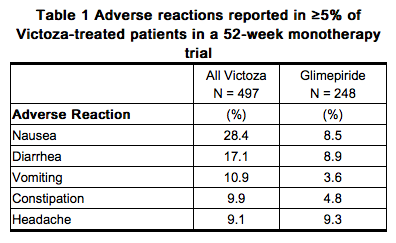
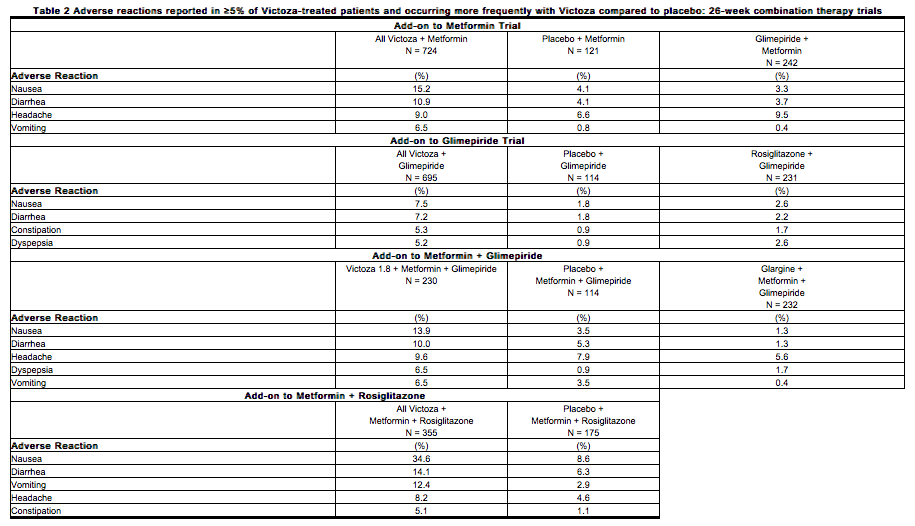


- Immunogenicity
- Consistent with the potentially immunogenic properties of protein and peptide pharmaceuticals, patients treated with Victoza may develop anti-liraglutide antibodies. Approximately 50-70% of Victoza-treated patients in the five double-blind clinical trials of 26 weeks duration or longer were tested for the presence of anti-liraglutide antibodies at the end of treatment. Low titers (concentrations not requiring dilution of serum) of anti-liraglutide antibodies were detected in 8.6% of these Victoza-treated patients. Sampling was not performed uniformly across all patients in the clinical trials, and this may have resulted in an underestimate of the actual percentage of patients who developed antibodies. Cross-reacting anti-liraglutide antibodies to native glucagon-like peptide-1 (GLP-1) occurred in 6.9% of the Victoza-treated patients in the double-blind 52-week monotherapy trial and in 4.8% of the Victoza-treated patients in the double-blind 26-week add-on combination therapy trials. These cross-reacting antibodies were not tested for neutralizing effect against native GLP-1, and thus the potential for clinically significant neutralization of native GLP-1 was not assessed. Antibodies that had a neutralizing effect on liraglutide in an in vitro assay occurred in 2.3% of the Victoza-treated patients in the double-blind 52-week monotherapy trial and in 1.0% of the Victoza-treated patients in the double-blind 26-week add-on combination therapy trials.
- Among Victoza-treated patients who developed anti-liraglutide antibodies, the most common category of adverse events was that of infections, which occurred among 40% of these patients compared to 36%, 34% and 35% of antibody-negative Victoza-treated, placebo-treated and active-control-treated patients, respectively. The specific infections which occurred with greater frequency among Victoza-treated antibody-positive patients were primarily nonserious upper respiratory tract infections, which occurred among 11% of Victoza-treated antibody-positive patients; and among 7%, 7% and 5% of antibody-negative Victoza-treated, placebo-treated and active-control-treated patients, respectively. Among Victoza-treated antibody-negative patients, the most common category of adverse events was that of gastrointestinal events, which occurred in 43%, 18% and 19% of antibody-negative Victoza-treated, placebo-treated and active-control-treated patients, respectively. Antibody formation was not associated with reduced efficacy of Victoza when comparing mean HbA1c of all antibody-positive and all antibody-negative patients. However, the 3 patients with the highest titers of anti-liraglutide antibodies had no reduction in HbA1c with Victoza treatment.
- In the five double-blind clinical trials of Victoza, events from a composite of adverse events potentially related to immunogenicity (e.g. urticaria, angioedema) occurred among 0.8% of Victoza-treated patients and among 0.4% of comparator-treated patients. Urticaria accounted for approximately one-half of the events in this composite for Victoza-treated patients. :*Patients who developed anti-liraglutide antibodies were not more likely to develop events from the immunogenicity events composite than were patients who did not develop anti-liraglutide antibodies.
- Injection site reactions
- Papillary thyroid carcinoma
- In clinical trials of Victoza, there were 7 reported cases of papillary thyroid carcinoma in patients treated with Victoza and 1 case in a comparator-treated patient (1.5 vs. 0.5 cases per 1000 patient-years). Most of these papillary thyroid carcinomas were <1 cm in greatest diameter and were diagnosed in surgical pathology specimens after thyroidectomy prompted by findings on protocol-specified screening with serum calcitonin or thyroid ultrasound.
- Hypoglycemia
- In the eight clinical trials of at least 26 weeks duration, hypoglycemia requiring the assistance of another person for treatment occurred in 11 Victoza-treated patients (2.3 cases per 1000 patient-years) and in two exenatide-treated patients. Of these 11 Victoza-treated patients, six patients were concomitantly using metformin and a sulfonylurea, one was concomitantly using a sulfonylurea, two were concomitantly using metformin (blood glucose values were 65 and 94 mg/dL) and two were using Victoza as monotherapy (one of these patients was undergoing an intravenous glucose tolerance test and the other was receiving insulin as treatment during a hospital stay). For these two patients on Victoza monotherapy, the insulin treatment was the likely explanation for the hypoglycemia.
- In the 26-week open-label trial comparing Victoza to sitagliptin, the incidence of hypoglycemic events defined as symptoms accompanied by a fingerstick glucose <56 mg/dL was comparable among the treatment groups (approximately 5%).
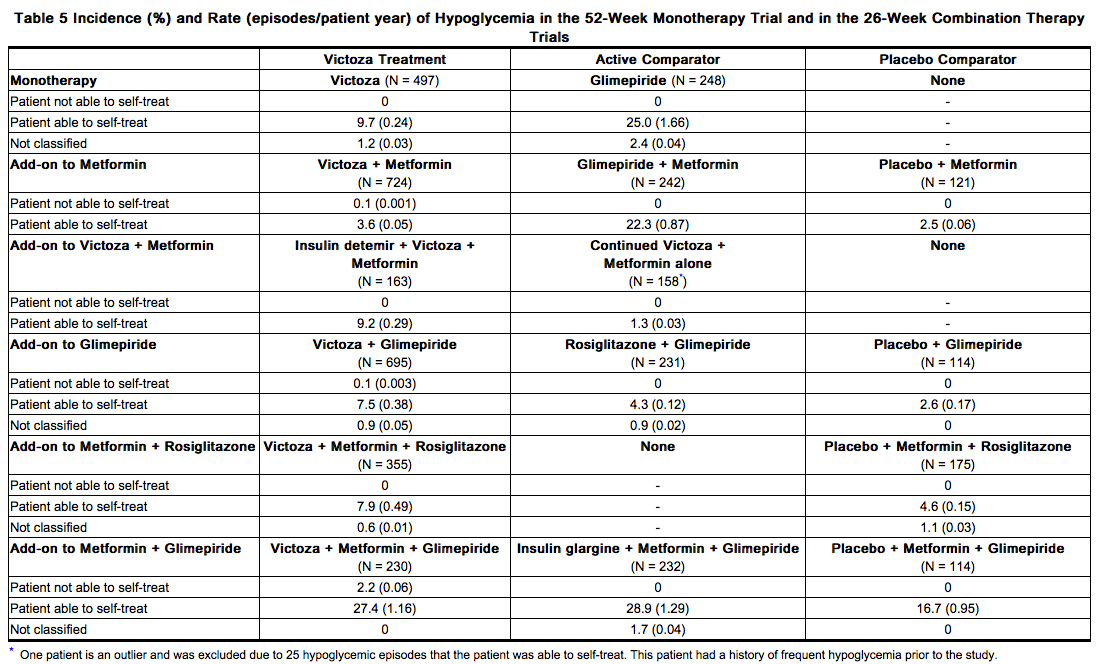
- In a pooled analysis of clinical trials, the incidence rate (per 1,000 patient-years) for malignant neoplasms (based on investigator-reported events, medical history, pathology reports, and surgical reports from both blinded and open-label study periods) was 10.9 for Victoza, 6.3 for placebo, and 7.2 for active comparator. After excluding papillary thyroid carcinoma events , no particular cancer cell type predominated. Seven malignant neoplasm events were reported beyond 1 year of exposure to study medication, six events among Victoza-treated patients (4 colon, 1 prostate and 1 nasopharyngeal), no events with placebo and one event with active comparator (colon). Causality has not been established.
Laboratory Tests
- In the five clinical trials of at least 26 weeks duration, mildly elevated serum bilirubin concentrations (elevations to no more than twice the upper limit of the reference range) occurred in 4.0% of Victoza-treated patients, 2.1% of placebo-treated patients and 3.5% of active-comparator-treated patients. This finding was not accompanied by abnormalities in other liver tests. The significance of this isolated finding is unknown.
Vital signs
- Victoza did not have adverse effects on blood pressure. Mean increases from baseline in heart rate of 2 to 3 beats per minute have been observed with Victoza compared to placebo. The long-term clinical effects of the increase in pulse rate have not been established.
Postmarketing Experience
- The following additional adverse reactions have been reported during post-approval use of Victoza. Because these events are reported voluntarily from a population of uncertain size, it is generally not possible to reliably estimate their frequency or establish a causal relationship to drug exposure.
- Dehydration resulting from nausea, vomiting and diarrhea.
- Increased serum creatinine, acute renal failure or worsening of chronic renal failure, sometimes requiring hemodialysis.
- Acute pancreatitis, hemorrhagic and necrotizing pancreatitis sometimes resulting in death
Drug Interactions
Oral Medications
- Victoza causes a delay of gastric emptying, and thereby has the potential to impact the absorption of concomitantly administered oral medications. In clinical pharmacology trials, Victoza did not affect the absorption of the tested orally administered medications to any clinically relevant degree. Nonetheless, caution should be exercised when oral medications are concomitantly administered with Victoza.
Use in Specific Populations
Pregnancy
- There are no adequate and well-controlled studies of Victoza in pregnant women. Victoza should be used during pregnancy only if the potential benefit justifies the potential risk to the fetus. Liraglutide has been shown to be teratogenic in rats at or above 0.8 times the human systemic exposures resulting from the maximum recommended human dose (MRHD) of 1.8 mg/day based on plasma area under the time-concentration curve (AUC). Liraglutide has been shown to cause reduced growth and increased total major abnormalities in rabbits at systemic exposures below human exposure at the MRHD based on plasma AUC.
- Female rats given subcutaneous doses of 0.1, 0.25 and 1.0 mg/kg/day liraglutide beginning 2 weeks before mating through gestation day 17 had estimated systemic exposures 0.8-, 3-, and 11-times the human exposure at the MRHD based on plasma AUC comparison. The number of early embryonic deaths in the 1 mg/kg/day group increased slightly. Fetal abnormalities and variations in kidneys and blood vessels, irregular ossification of the skull, and a more complete state of ossification occurred at all doses. Mottled liver and minimally kinked ribs occurred at the highest dose. The incidence of fetal malformations in liraglutide-treated groups exceeding concurrent and historical controls were misshapen oropharynx and/or narrowed opening into larynx at 0.1 mg/kg/day and umbilical hernia at 0.1 and 0.25 mg/kg/day.
- Pregnant rabbits given subcutaneous doses of 0.01, 0.025 and 0.05 mg/kg/day liraglutide from gestation day 6 through day 18 inclusive, had estimated systemic exposures less than the human exposure at the MRHD of 1.8 mg/day at all doses, based on plasma AUC. Liraglutide decreased fetal weight and dose-dependently increased the incidence of total major fetal abnormalities at all doses. The incidence of malformations exceeded concurrent and historical controls at 0.01 mg/kg/day (kidneys, scapula), ≥ 0.01 mg/kg/day (eyes, forelimb), 0.025 mg/kg/day (brain, tail and sacral vertebrae, major blood vessels and heart, umbilicus), ≥ 0.025 mg/kg/day (sternum) and at 0.05 mg/kg/day (parietal bones, major blood vessels). Irregular ossification and/or skeletal abnormalities occurred in the skull and jaw, vertebrae and ribs, sternum, pelvis, tail, and scapula; and dose-dependent minor skeletal variations were observed. Visceral abnormalities occurred in blood vessels, lung, liver, and esophagus. Bilobed or bifurcated gallbladder was seen in all treatment groups, but not in the control group.
- In pregnant female rats given subcutaneous doses of 0.1, 0.25 and 1.0 mg/kg/day liraglutide from gestation day 6 through weaning or termination of nursing on lactation day 24, estimated systemic exposures were 0.8-, 3-, and 11-times human exposure at the MRHD of 1.8 mg/day, based on plasma AUC. A slight delay in parturition was observed in the majority of treated rats. Group mean body weight of neonatal rats from liraglutide-treated dams was lower than neonatal rats from control group dams. Bloody scabs and agitated behavior occurred in male rats descended from dams treated with 1 mg/kg/day liraglutide. Group mean body weight from birth to postpartum day 14 trended lower in F2 generation rats descended from liraglutide-treated rats compared to F2 generation rats descended from controls, but differences did not reach statistical significance for any group.
Pregnancy Category (AUS):
There is no Australian Drug Evaluation Committee (ADEC) guidance on usage of Liraglutide in women who are pregnant.
Labor and Delivery
There is no FDA guidance on use of Liraglutide during labor and delivery.
Nursing Mothers
- It is not known whether Victoza is excreted in human milk. Because many drugs are excreted in human milk and because of the potential for tumorigenicity shown for liraglutide in animal studies, a decision should be made whether to discontinue nursing or to discontinue Victoza, taking into account the importance of the drug to the mother. In lactating rats, liraglutide was excreted unchanged in milk at concentrations approximately 50% of maternal plasma concentrations.
Pediatric Use
- Safety and effectiveness of Victoza have not been established in pediatric patients. Victoza is not recommended for use in pediatric patients.
Geriatic Use
- In the Victoza clinical trials, a total of 797 (20%) of the patients were 65 years of age and over and 113 (2.8%) were 75 years of age and over. No overall differences in safety or effectiveness were observed between these patients and younger patients, but greater sensitivity of some older individuals cannot be ruled out.
Gender
There is no FDA guidance on the use of Liraglutide with respect to specific gender populations.
Race
There is no FDA guidance on the use of Liraglutide with respect to specific racial populations.
Renal Impairment
- There is limited experience with Victoza in patients with mild, moderate, and severe renal impairment, including end-stage renal disease. However, there have been postmarketing reports of acute renal failure and worsening of chronic renal failure, which may sometimes require hemodialysis . Victoza should be used with caution in this patient population. No dose adjustment of Victoza is recommended for patients with renal impairment.
Hepatic Impairment
- There is limited experience in patients with mild, moderate or severe hepatic impairment. Therefore, Victoza should be used with caution in this patient population. No dose adjustment of Victoza is recommended for patients with hepatic impairment.
Females of Reproductive Potential and Males
There is no FDA guidance on the use of Liraglutide in women of reproductive potentials and males.
Immunocompromised Patients
There is no FDA guidance one the use of Liraglutide in patients who are immunocompromised.
Gastroparesis
- Victoza slows gastric emptying. Victoza has not been studied in patients with pre-existing gastroparesis.
Administration and Monitoring
Administration
Intramuscular
Monitoring
FDA Package Insert for Abcixmab contains no information regarding drug monitoring.
IV Compatibility
There is limited information about the IV Compatibility.
Overdosage
- Overdoses have been reported in clinical trials and post-marketing use of Victoza. Effects have included severe nausea and severe vomiting. In the event of overdosage, appropriate supportive treatment should be initiated according to the patient’s clinical signs and symptoms.
Pharmacology
Mechanism of Action
- Liraglutide is an acylated human Glucagon-Like Peptide-1 (GLP-1) receptor agonist with 97% amino acid sequence homology to endogenous human GLP-1(7-37). GLP-1(7-37) represents <20% of total circulating endogenous GLP-1. Like GLP-1(7-37), liraglutide activates the GLP-1 receptor, a membrane-bound cell-surface receptor coupled to adenylyl cyclase by the stimulatory G-protein, Gs, in pancreatic beta cells. Liraglutide increases intracellular cyclic AMP (cAMP) leading to insulin release in the presence of elevated glucose concentrations. *This insulin secretion subsides as blood glucose concentrations decrease and approach euglycemia. Liraglutide also decreases glucagon secretion in a glucose-dependent manner. The mechanism of blood glucose lowering also involves a delay in gastric emptying.
- GLP-1(7-37) has a half-life of 1.5-2 minutes due to degradation by the ubiquitous endogenous enzymes, dipeptidyl peptidase IV (DPP-IV) and neutral endopeptidases (NEP). Unlike native GLP-1, liraglutide is stable against metabolic degradation by both peptidases and has a plasma half-life of 13 hours after subcutaneous administration. The pharmacokinetic profile of liraglutide, which makes it suitable for once daily administration, is a result of self-association that delays absorption, plasma protein binding and stability against metabolic degradation by DPP-IV and NEP.
Structure
- Victoza contains liraglutide, an analog of human GLP-1 and acts as a GLP-1 receptor agonist. The peptide precursor of liraglutide, produced by a process that includes expression of recombinant DNA in Saccharomyces cerevisiae, has been engineered to be 97% homologous to native human GLP-1 by substituting arginine for lysine at position 34. Liraglutide is made by attaching a C-16 fatty acid (palmitic acid) with a glutamic acid spacer on the remaining lysine residue at position 26 of the peptide precursor. The molecular formula of liraglutide is C172H265N43O51 and the molecular weight is 3751.2 Daltons. The structural formula (Figure 1) is:
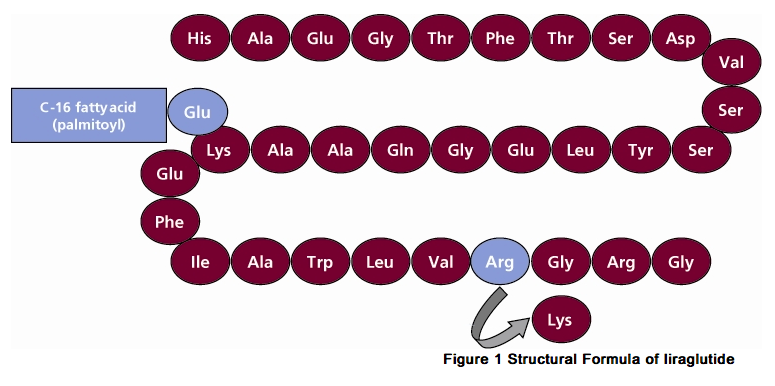
- Victoza is a clear, colorless solution. Each 1 mL of Victoza solution contains 6 mg of liraglutide. Each pre-filled pen contains a 3 mL solution of Victoza equivalent to 18 mg liraglutide (free-base, anhydrous) and the following inactive ingredients: disodium phosphate dihydrate, 1.42 mg; propylene glycol, 14 mg; phenol, 5.5 mg; and water for injection.
Pharmacodynamics
- Victoza’s pharmacodynamic profile is consistent with its pharmacokinetic profile observed after single subcutaneous administration as Victoza lowered fasting, premeal and postprandial glucose throughout the day.
- Fasting and postprandial glucose was measured before and up to 5 hours after a standardized meal after treatment to steady state with 0.6, 1.2 and 1.8 mg Victoza or placebo. Compared to placebo, the postprandial plasma glucose AUC0-300min was 35% lower after Victoza 1.2 mg and 38% lower after Victoza 1.8 mg.
Glucose-dependent insulin secretion
- The effect of a single dose of 7.5 mcg/kg (~ 0.7 mg) Victoza on insulin secretion rates (ISR) was investigated in 10 patients with type 2 diabetes during graded glucose infusion. In these patients, on average, the ISR response was increased in a glucose-dependent manner (Figure 2).

Glucagon secretion
- Victoza lowered blood glucose by stimulating insulin secretion and lowering glucagon secretion. A single dose of Victoza 7.5 mcg/kg (~ 0.7 mg) did not impair glucagon response to low glucose concentrations.
Gastric emptying
- Victoza causes a delay of gastric emptying, thereby reducing the rate at which postprandial glucose appears in the circulation.
Cardiac Electrophysiology (QTc)
- The effect of Victoza on cardiac repolarization was tested in a QTc study. Victoza at steady state concentrations with daily doses up to 1.8 mg did not produce QTc prolongation.
Pharmacokinetics
Absorption
- Following subcutaneous administration, maximum concentrations of liraglutide are achieved at 8-12 hours post dosing. The mean peak (Cmax) and total (AUC) exposures of liraglutide were 35 ng/mL and 960 ng·h/mL, respectively, for a subcutaneous single dose of 0.6 mg. After subcutaneous single dose administrations, Cmax and AUC of liraglutide increased proportionally over the therapeutic dose range of 0.6 mg to 1.8 mg. At 1.8 mg Victoza, the average steady state concentration of liraglutide over 24 hours was approximately 128 ng/mL. AUC0-∞ was equivalent between upper arm and abdomen, and between upper arm and thigh. AUC0-∞ from thigh was 22% lower than that from abdomen. However, liraglutide exposures were considered comparable among these three subcutaneous injection sites. Absolute bioavailability of liraglutide following subcutaneous administration is approximately 55%.
Distribution
- The mean apparent volume of distribution after subcutaneous administration of Victoza 0.6 mg is approximately 13 L. The mean volume of distribution after intravenous administration of Victoza is 0.07 L/kg. Liraglutide is extensively bound to plasma protein (>98%).
Metabolism
- During the initial 24 hours following administration of a single [3H]-liraglutide dose to healthy subjects, the major component in plasma was intact liraglutide. Liraglutide is endogenously metabolized in a similar manner to large proteins without a specific organ as a major route of elimination.
Elimination
- Following a [3H]-liraglutide dose, intact liraglutide was not detected in urine or feces. Only a minor part of the administered radioactivity was excreted as liraglutide-related metabolites in urine or feces (6% and 5%, respectively). The majority of urine and feces radioactivity was excreted during the first 6-8 days. The mean apparent clearance following subcutaneous administration of a single dose of liraglutide is approximately 1.2 L/h with an elimination half-life of approximately 13 hours, making Victoza suitable for once daily administration.
Specific Populations
Elderly
- Age had no effect on the pharmacokinetics of Victoza based on a pharmacokinetic study in healthy elderly subjects (65 to 83 years) and population pharmacokinetic analyses of patients 18 to 80 years of age .
Gender
- Based on the results of population pharmacokinetic analyses, females have 34% lower weight-adjusted clearance of Victoza compared to males. Based on the exposure response data, no dose adjustment is necessary based on gender.
Race and Ethnicity
- Race and ethnicity had no effect on the pharmacokinetics of Victoza based on the results of population pharmacokinetic analyses that included Caucasian, Black, Asian and Hispanic/Non-Hispanic subjects.
Body Weight
- Body weight significantly affects the pharmacokinetics of Victoza based on results of population pharmacokinetic analyses. The exposure of liraglutide decreases with an increase in baseline body weight. However, the 1.2 mg and 1.8 mg daily doses of Victoza provided adequate systemic exposures over the body weight range of 40 – 160 kg evaluated in the clinical trials. *Liraglutide was not studied in patients with body weight >160 kg.
Pediatric
- Victoza has not been studied in pediatric patients .
Renal Impairment
- The single-dose pharmacokinetics of Victoza were evaluated in subjects with varying degrees of renal impairment. Subjects with mild (estimated creatinine clearance 50-80 mL/min) to severe (estimated creatinine clearance <30 mL/min) renal impairment and subjects with end-stage renal disease requiring dialysis were included in the trial. Compared to healthy subjects, liraglutide AUC in mild, moderate, and severe renal impairment and in end-stage renal disease was on average 35%, 19%, 29% and 30% lower, respectively [see Use in Specific Populations (8.6)].
Hepatic Impairment
- The single-dose pharmacokinetics of Victoza were evaluated in subjects with varying degrees of hepatic impairment. Subjects with mild (Child Pugh score 5-6) to severe (Child Pugh score > 9) hepatic impairment were included in the trial. Compared to healthy subjects, liraglutide AUC in subjects with mild, moderate and severe hepatic impairment was on average 11%, 14% and 42% lower, respectively
Drug Interactions
In vitro assessment of drug-drug interactions
- Victoza has low potential for pharmacokinetic drug-drug interactions related to cytochrome P450 (CYP) and plasma protein binding.
In vivo assessment of drug-drug interactions
- The drug-drug interaction studies were performed at steady state with Victoza 1.8 mg/day. Before administration of concomitant treatment, subjects underwent a 0.6 mg weekly dose increase to reach the maximum dose of 1.8 mg/day. Administration of the interacting drugs was timed so that Cmax of Victoza (8-12 h) would coincide with the absorption peak of the co-administered drugs.
Digoxin
- A single dose of Digoxin 1 mg was administered 7 hours after the dose of Victoza at steady state. The concomitant administration with Victoza resulted in a reduction of Digoxin AUC by 16%; Cmax decreased by 31%. Digoxin median time to maximal concentration (Tmax) was delayed from 1 h to 1.5 h.
Lisinopril
- A single dose of Lisinopril 20 mg was administered 5 minutes after the dose of Victoza at steady state. The co-administration with Victoza resulted in a reduction of Lisinopril AUC by 15%; Cmax decreased by 27%. Lisinopril median Tmax was delayed from 6 h to 8 h with Victoza.
Atorvastatin
- Victoza did not change the overall exposure (AUC) of Atorvastatin following a single dose of Atorvastatin 40 mg, administered 5 hours after the dose of Victoza at steady state. Atorvastatin Cmax was decreased by 38% and median Tmax was delayed from 1 h to 3 h with Victoza.
Acetaminophen
- Victoza did not change the overall exposure (AUC) of Acetaminophen following a single dose of Acetaminophen 1000 mg, administered 8 hours after the dose of Victoza at steady state. Acetaminophen Cmax was decreased by 31% and median Tmax was delayed up to 15 minutes.
Griseofulvin
- Victoza did not change the overall exposure (AUC) of Griseofulvin following co-administration of a single dose of Griseofulvin 500 mg with Victoza at steady state. Griseofulvin Cmax increased by 37% while median Tmax did not change.
Oral Contraceptives
- A single dose of an oral contraceptive combination product containing 0.03 mg ethinylestradiol and 0.15 mg levonorgestrel was administered under fed conditions and 7 hours after the dose of Victoza at steady state. Victoza lowered ethinylestradiol and levonorgestrel Cmax by 12% and 13%, respectively. There was no effect of Victoza on the overall exposure (AUC) of ethinylestradiol. Victoza increased the levonorgestrel AUC0-∞ by 18%. Victoza delayed Tmax for both ethinylestradiol and levonorgestrel by 1.5 h.
Insulin Detemir
- No pharmacokinetic interaction was observed between Victoza and insulin detemir when separate subcutaneous injections of insulin detemir 0.5 Unit/kg (single-dose) and Victoza 1.8 mg (steady state) were administered in patients with type 2 diabetes.
Nonclinical Toxicology
Carcinogenesis, Mutagenesis, Impairment of Fertility
- A 104-week carcinogenicity study was conducted in male and female CD-1 mice at doses of 0.03, 0.2, 1.0, and 3.0 mg/kg/day liraglutide administered by bolus subcutaneous injection yielding systemic exposures 0.2-, 2-, 10- and 45-times the human exposure, respectively, at the MRHD of 1.8 mg/day based on plasma AUC comparison. A dose-related increase in benign thyroid C-cell adenomas was seen in the 1.0 and the 3.0 mg/kg/day groups with incidences of 13% and 19% in males and 6% and 20% in females, respectively. C-cell adenomas did not occur in control groups or 0.03 and 0.2 mg/kg/day groups. Treatment-related malignant C-cell carcinomas occurred in 3% of females in the 3.0 mg/kg/day group. Thyroid C-cell tumors are rare findings during carcinogenicity testing in mice. A treatment-related increase in fibrosarcomas was seen on the dorsal skin and subcutis, the body surface used for drug injection, in males in the 3 mg/kg/day group. These fibrosarcomas were attributed to the high local concentration of drug near the injection site. The liraglutide concentration in the clinical formulation (6 mg/mL) is 10-times higher than the concentration in the formulation used to administer 3 mg/kg/day liraglutide to mice in the carcinogenicity study (0.6 mg/mL).
- A 104-week carcinogenicity study was conducted in male and female Sprague Dawley rats at doses of 0.075, 0.25 and 0.75 mg/kg/day liraglutide administered by bolus subcutaneous injection with exposures 0.5-, 2- and 8-times the human exposure, respectively, resulting from the MRHD based on plasma AUC comparison. A treatment-related increase in benign thyroid C-cell adenomas was seen in males in 0.25 and 0.75 mg/kg/day liraglutide groups with incidences of 12%, 16%, 42%, and 46% and in all female liraglutide-treated groups with incidences of 10%, 27%, 33%, and 56% in 0 (control), 0.075, 0.25, and 0.75 mg/kg/day groups, respectively. A treatment-related increase in malignant thyroid C-cell carcinomas was observed in all male liraglutide-treated groups with incidences of 2%, 8%, 6%, and 14% and in females at 0.25 and 0.75 mg/kg/day with incidences of 0%, 0%, 4%, and 6% in 0 (control), 0.075, 0.25, and 0.75 mg/kg/day groups, respectively. Thyroid C-cell carcinomas are rare findings during carcinogenicity testing in rats.
- Human relevance of thyroid C-cell tumors in mice and rats is unknown and could not be determined by clinical studies or nonclinical studies.
- Liraglutide was negative with and without metabolic activation in the Ames test for mutagenicity and in a human peripheral blood lymphocyte chromosome aberration test for clastogenicity. Liraglutide was negative in repeat-dose in vivo micronucleus tests in rats.
- In rat fertility studies using subcutaneous doses of 0.1, 0.25 and 1.0 mg/kg/day liraglutide, males were treated for 4 weeks prior to and throughout mating and females were treated 2 weeks prior to and throughout mating until gestation day 17. No direct adverse effects on male fertility was observed at doses up to 1.0 mg/kg/day, a high dose yielding an estimated systemic exposure 11- times the human exposure at the MRHD, based on plasma AUC. In female rats, an increase in early embryonic deaths occurred at 1.0 mg/kg/day. Reduced body weight gain and food consumption were observed in females at the 1.0 mg/kg/day dose.
Clinical Studies
- A total of 6090 patients with type 2 diabetes participated in 8 phase 3 trials. There were 5 double-blind (one of these trials had an open-label active control insulin glargine arm), randomized, controlled clinical trials, one of 52 weeks duration and four of 26 weeks duration. There were also three 26 week open-label trials; one comparing Victoza to twice-daily exenatide, one comparing Victoza to sitagliptin and one comparing Victoza+metformin+insulin detemir to Victoza+metformin alone. These multinational trials were conducted to evaluate the glycemic efficacy and safety of Victoza in type 2 diabetes as monotherapy and in combination with one or two oral anti-diabetic medications or insulin detemir. The 7 add-on combination therapy trials enrolled patients who were previously treated with anti-diabetic therapy, and approximately two-thirds of patients in the monotherapy trial also were previously treated with anti-diabetic therapy. In total, 272 (4%) of the 6090 patients in these 8 trials were new to anti-diabetic therapy. In these 8 clinical trials, patients ranged in age from 18-80 years old and 54% were men. Approximately 82% of patients were Caucasian, and 6% were Black. In the 5 trials where ethnicity was captured, 10% of patients were Hispanic/Latino (n=630).
- In each of the placebo controlled trials, treatment with Victoza produced clinically and statistically significant improvements in hemoglobin A1c and fasting plasma glucose (FPG) compared to placebo.
- All Victoza-treated patients started at 0.6 mg/day. The dose was increased in weekly intervals by 0.6 mg to reach 1.2 mg or 1.8 mg for patients randomized to these higher doses. Victoza 0.6 mg is not effective for glycemic control and is intended only as a starting dose to reduce gastrointestinal intolerance .
Monotherapy
- In this 52-week trial, 746 patients were randomized to Victoza 1.2 mg, Victoza 1.8 mg, or glimepiride 8 mg. Patients who were randomized to glimepiride were initially treated with 2 mg daily for two weeks, increasing to 4 mg daily for another two weeks, and finally increasing to 8 mg daily. Treatment with Victoza 1.8 mg and 1.2 mg resulted in a statistically significant reduction in HbA1c compared to glimepiride (Table 6). The percentage of patients who discontinued due to ineffective therapy was 3.6% in the Victoza 1.8 mg treatment group, 6.0% in the Victoza 1.2 mg treatment group, and 10.1% in the glimepiride-treatment group.
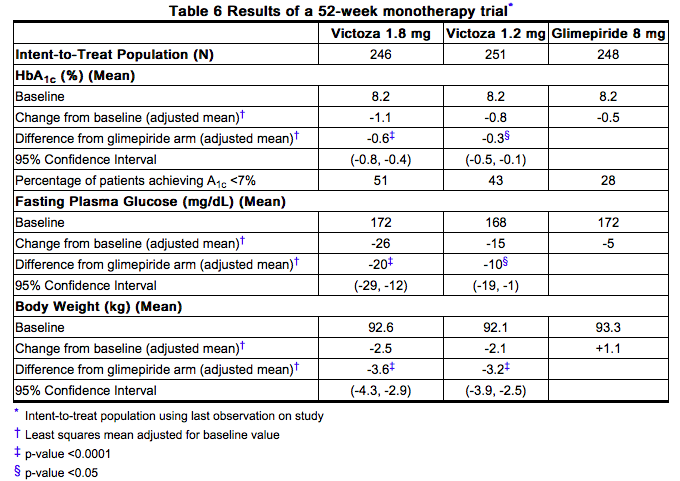

Combination Therapy
Add-on to metformin
- In this 26-week trial, 1091 patients were randomized to Victoza 0.6 mg, Victoza 1.2 mg, Victoza 1.8 mg, placebo, or glimepiride 4 mg (one-half of the maximal approved dose in the United States), all as add-on to metformin. Randomization occurred after a 6-week run-in period consisting of a 3-week initial forced metformin titration period followed by a maintenance period of another 3 weeks. During the titration period, doses of metformin were increased up to 2000 mg/day.
- Treatment with Victoza 1.2 mg and 1.8 mg as add-on to metformin resulted in a significant mean HbA1c reduction relative to placebo add-on to metformin and resulted in a similar mean HbA1c reduction relative to glimepiride 4 mg add-on to metformin (Table 7). The percentage of patients who discontinued due to ineffective therapy was 5.4% in the Victoza 1.8 mg + metformin treatment group, 3.3% in the Victoza 1.2 mg + metformin treatment group, 23.8% in the placebo + metformin treatment group, and 3.7% in the glimepiride + metformin treated group.
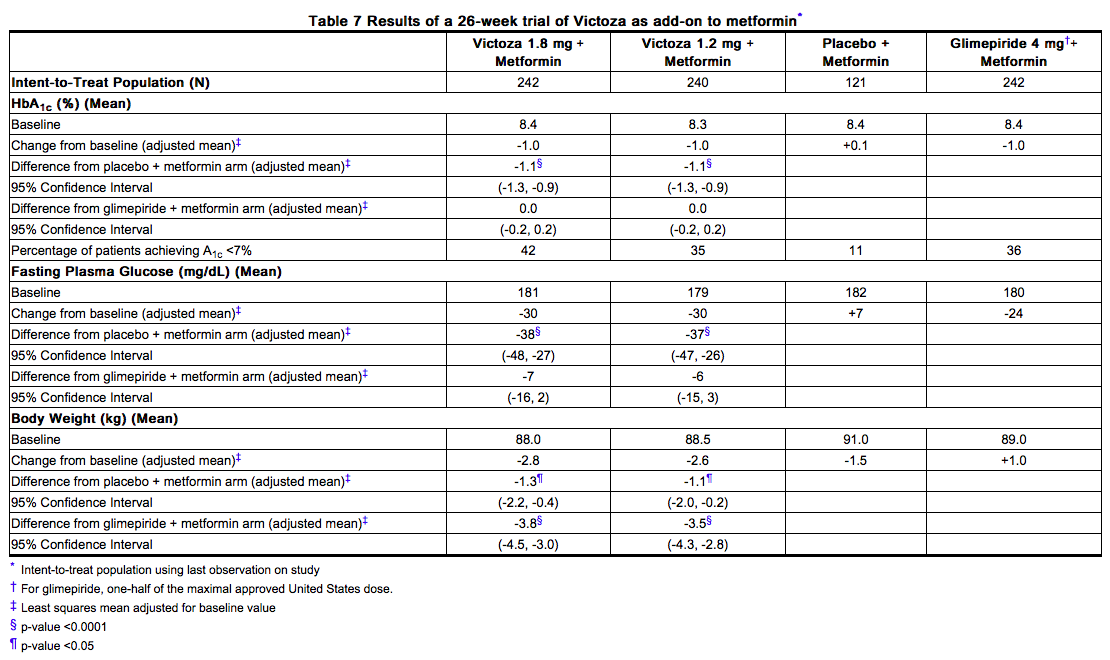
Victoza Compared to Sitagliptin, Both as Add-on to metformin
- In this 26–week, open-label trial, 665 patients on a background of metformin ≥1500 mg per day were randomized to Victoza 1.2 mg once-daily, Victoza 1.8 mg once-daily or sitagliptin 100 mg once-daily, all dosed according to approved labeling. Patients were to continue their current treatment on metformin at a stable, pre-trial dose level and dosing frequency.
The primary endpoint was the change in HbA1c from baseline to Week 26. Treatment with Victoza 1.2 mg and Victoza 1.8 mg resulted in statistically significant reductions in HbA1c relative to sitagliptin 100 mg (Table 8). The percentage of patients who discontinued due to ineffective therapy was 3.1% in the Victoza 1.2 mg group, 0.5% in the Victoza 1.8 mg treatment group, and 4.1% in the sitagliptin 100 mg treatment group. From a mean baseline body weight of 94 kg, there was a mean reduction of 2.7 kg for Victoza 1.2 mg, 3.3 kg for Victoza 1.8 mg, and 0.8 kg for sitagliptin 100 mg.

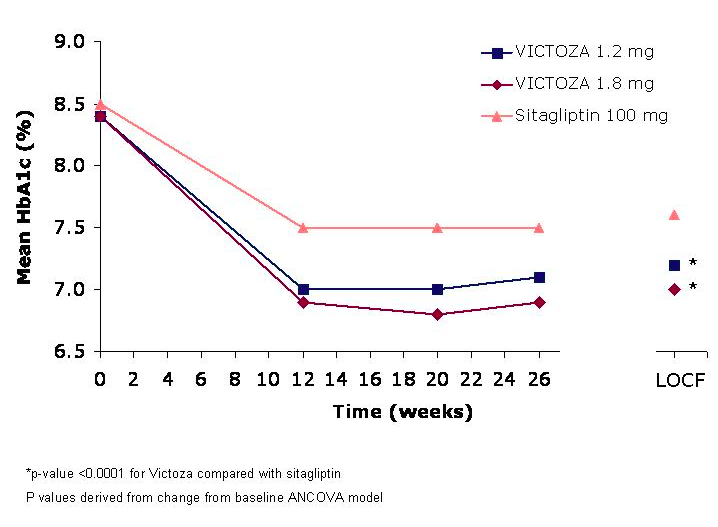
Figure 4 Mean HbA1c for patients who completed the 26-week trial and for the Last Observation Carried Forward (LOCF, intent-to-treat) data at Week 26
Combination Therapy with metformin and Insulin
- This 26-week open-label trial enrolled 988 patients with inadequate glycemic control (HbA1c 7-10%) on metformin (≥1500 mg/day) alone or inadequate glycemic control (HbA1c 7-8.5%) on metformin (≥1500 mg/day) and a sulfonylurea. Patients who were on metformin and a sulfonylurea discontinued the sulfonylurea then all patients entered a 12-week run-in period during which they received add-on therapy with Victoza titrated to 1.8 mg once-daily. At the end of the run-in period, 498 patients (50%) achieved HbA1c <7% with Victoza 1.8 mg and metformin and continued treatment in a non-randomized, observational arm. Another 167 patients (17%) withdrew from the trial during the run-in period with approximately one-half of these patients doing so because of gastrointestinal adverse reactions [see Adverse Reactions (6.1)]. The remaining 323 patients with HbA1c ≥7% (33% of those who entered the run-in period) were randomized to 26 weeks of once-daily insulin detemir administered in the evening as add-on therapy (N=162) or to continued, unchanged treatment with Victoza 1.8 mg and metformin (N=161). The starting dose of insulin detemir was 10 units/day and the mean dose at the end of the 26-week randomized period was 39 units/day. During the 26 week randomized treatment period, the percentage of patients who discontinued due to ineffective therapy was 11.2% in the group randomized to continued treatment with Victoza 1.8 mg and metformin and 1.2% in the group randomized to add-on therapy with insulin detemir.
Treatment with insulin detemir as add-on to Victoza 1.8 mg + metformin resulted in statistically significant reductions in HbA1c and FPG compared to continued, unchanged treatment with Victoza 1.8 mg + metformin alone (Table 9). From a mean baseline body weight of 96 kg after randomization, there was a mean reduction of 0.3 kg in the patients who received insulin detemir add-on therapy compared to a mean reduction of 1.1 kg in the patients who continued on unchanged treatment with Victoza 1.8 mg + metformin alone.

Add-on to Sulfonylurea
- In this 26-week trial, 1041 patients were randomized to Victoza 0.6 mg, Victoza 1.2 mg, Victoza 1.8 mg, placebo, or rosiglitazone 4 mg (one-half of the maximal approved dose in the United States), all as add-on to glimepiride. Randomization occurred after a 4-week run-in period consisting of an initial, 2-week, forced-glimepiride titration period followed by a maintenance period of another 2 weeks. During the titration period, doses of glimepiride were increased to 4 mg/day. The doses of glimepiride could be reduced (at the discretion of the investigator) from 4 mg/day to 3 mg/day or 2 mg/day (minimum) after randomization, in the event of unacceptable hypoglycemia or other adverse events.
Treatment with Victoza 1.2 mg and 1.8 mg as add-on to glimepiride resulted in a statistically significant reduction in mean HbA1c compared to placebo add-on to glimepiride (Table 10). The percentage of patients who discontinued due to ineffective therapy was 3.0% in the Victoza 1.8 mg + glimepiride treatment group, 3.5% in the Victoza 1.2 mg + glimepiride treatment group, 17.5% in the placebo + glimepiride treatment group, and 6.9% in the rosiglitazone + glimepiride treatment group.
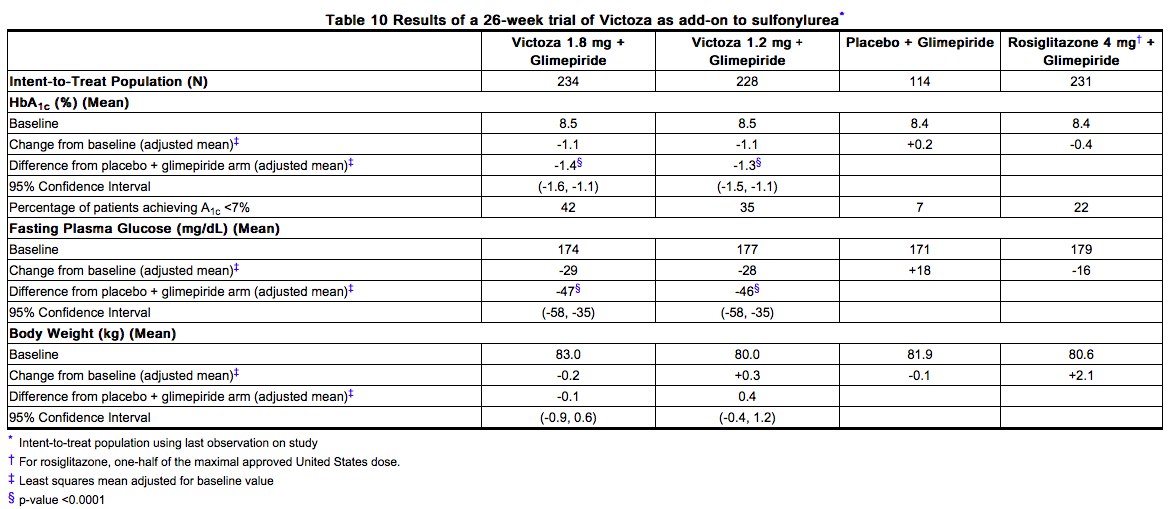
Add-on to metformin and Sulfonylurea
- In this 26-week trial, 581 patients were randomized to Victoza 1.8 mg, placebo, or insulin glargine, all as add-on to metformin and glimepiride. Randomization took place after a 6-week run-in period consisting of a 3-week forced metformin and glimepiride titration period followed by a maintenance period of another 3 weeks. During the titration period, doses of metformin and glimepiride were to be increased up to 2000 mg/day and 4 mg/day, respectively. After randomization, patients randomized to Victoza 1.8 mg underwent a 2 week period of titration with Victoza. During the trial, the Victoza and metformin doses were fixed, although glimepiride and insulin glargine doses could be adjusted. Patients titrated glargine twice-weekly during the first 8 weeks of treatment based on self-measured fasting plasma glucose on the day of titration. After Week 8, the frequency of insulin glargine titration was left to the discretion of the investigator, but, at a minimum, the glargine dose was to be revised, if necessary, at Weeks 12 and 18. Only 20% of glargine-treated patients achieved the pre-specified target fasting plasma glucose of ≤100 mg/dL. Therefore, optimal titration of the insulin glargine dose was not achieved in most patients.
Treatment with Victoza as add-on to glimepiride and metformin resulted in a statistically significant mean reduction in HbA1c compared to placebo add-on to glimepiride and metformin (Table 11). The percentage of patients who discontinued due to ineffective therapy was 0.9% in the Victoza 1.8 mg + metformin + glimepiride treatment group, 0.4% in the insulin glargine + metformin + glimepiride treatment group, and 11.3% in the placebo + metformin + glimepiride treatment group.
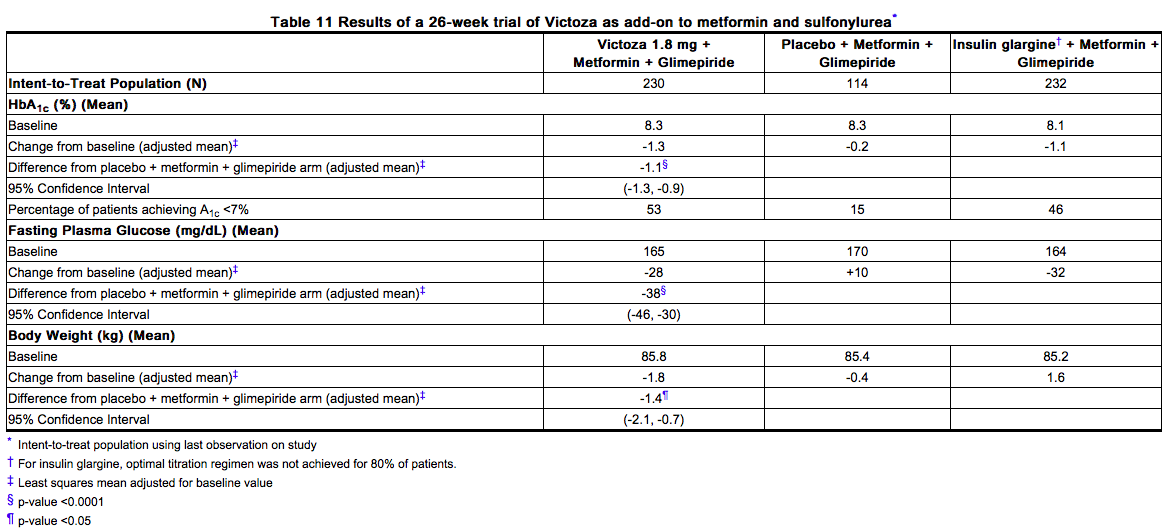
Victoza Compared to Exenatide, Both as Add-on to metformin and/or Sulfonylurea Therapy
- In this 26–week, open-label trial, 464 patients on a background of metformin monotherapy, sulfonylurea monotherapy or a combination of metformin and sulfonylurea were randomized to once daily Victoza 1.8 mg or exenatide 10 mcg twice daily. Maximally tolerated doses of background therapy were to remain unchanged for the duration of the trial. Patients randomized to exenatide started on a dose of 5 mcg twice-daily for 4 weeks and then were escalated to 10 mcg twice daily.
Treatment with Victoza 1.8 mg resulted in statistically significant reductions in HbA1c and FPG relative to exenatide (Table 12). The percentage of patients who discontinued for ineffective therapy was 0.4% in the Victoza treatment group and 0% in the exenatide treatment group. Both treatment groups had a mean decrease from baseline in body weight of approximately 3 kg.
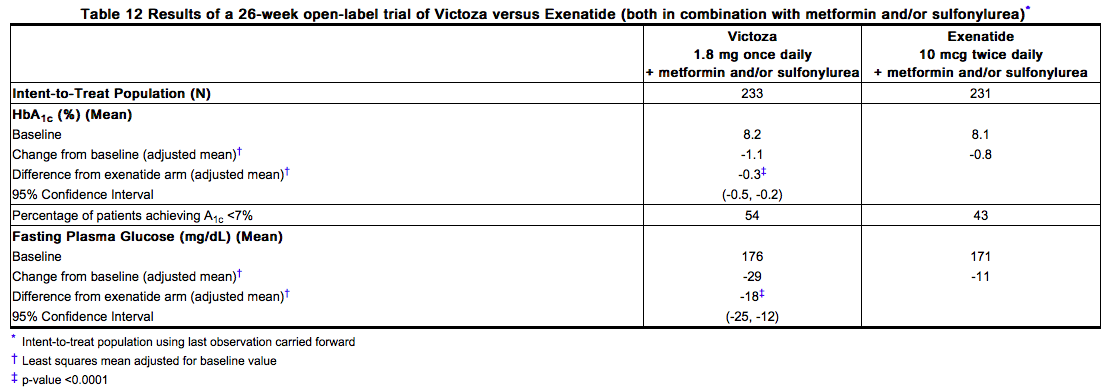
Add-on to metformin and Thiazolidinedione
- In this 26-week trial, 533 patients were randomized to Victoza 1.2 mg, Victoza 1.8 mg or placebo, all as add-on to rosiglitazone (8 mg) plus metformin (2000 mg). Patients underwent a 9 week run-in period (3-week forced dose escalation followed by a 6-week dose maintenance phase) with rosiglitazone (starting at 4 mg and increasing to 8 mg/day within 2 weeks) and metformin (starting at 500 mg with increasing weekly increments of 500 mg to a final dose of 2000 mg/day). Only patients who tolerated the final dose of rosiglitazone (8 mg/day) and metformin (2000 mg/day) and completed the 6-week dose maintenance phase were eligible for randomization into the trial.
Treatment with Victoza as add-on to metformin and rosiglitazone produced a statistically significant reduction in mean HbA1c compared to placebo add-on to metformin and rosiglitazone (Table 13). The percentage of patients who discontinued due to ineffective therapy was 1.7% in the Victoza 1.8 mg + metformin + rosiglitazone treatment group, 1.7% in the Victoza 1.2 mg + metformin + rosiglitazone treatment group, and 16.4% in the placebo + metformin + rosiglitazone treatment group.
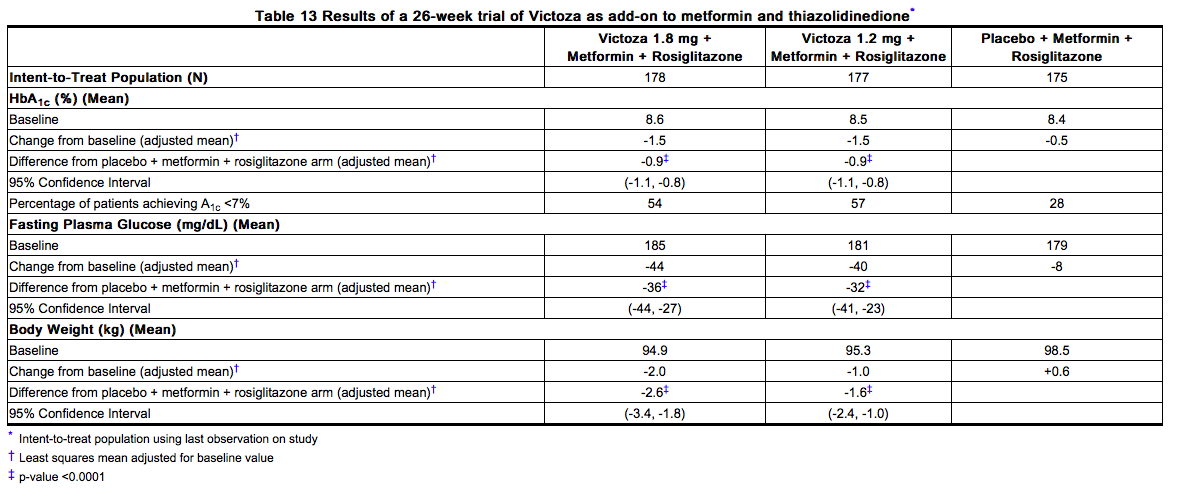
How Supplied
- Victoza is available in the following package sizes containing disposable, pre-filled, multi-dose pens. Each individual pen delivers doses of 0.6 mg, 1.2 mg, or 1.8 mg (6 mg/mL, 3 mL).
- 2 x Victoza pen NDC 0169-4060-12
- 3 x Victoza pen NDC 0169-4060-13
- Each Victoza pen is for use by a single patient. A Victoza pen should never be shared between patients, even if the needle is changed.
Storage
- Prior to first use, Victoza should be stored in a refrigerator between 36ºF to 46ºF (2ºC to 8ºC) (Table 14). Do not store in the freezer or directly adjacent to the refrigerator cooling element. Do not freeze Victoza and do not use Victoza if it has been frozen.
- After initial use of the Victoza pen, the pen can be stored for 30 days at controlled room temperature (59°F to 86°F; 15°C to 30°C) or in a refrigerator (36°F to 46°F; 2°C to 8°C). Keep the pen cap on when not in use. Victoza should be protected from excessive heat and sunlight. Always remove and safely discard the needle after each injection and store the Victoza pen without an injection needle attached. This will reduce the potential for contamination, infection, and leakage while also ensuring dosing accuracy.

Images
Drug Images
{{#ask: Page Name::Liraglutide |?Pill Name |?Drug Name |?Pill Ingred |?Pill Imprint |?Pill Dosage |?Pill Color |?Pill Shape |?Pill Size (mm) |?Pill Scoring |?NDC |?Drug Author |format=template |template=DrugPageImages |mainlabel=- |sort=Pill Name }}
Package and Label Display Panel
{{#ask: Label Page::Liraglutide |?Label Name |format=template |template=DrugLabelImages |mainlabel=- |sort=Label Page }}
Patient Counseling Information
FDA-Approved Medication Guide
See separate leaflet.
Risk of Thyroid C-cell Tumors
- Patients should be informed that liraglutide causes benign and malignant thyroid C-cell tumors in mice and rats and that the human relevance of this finding is unknown. Patients should be counseled to report symptoms of thyroid tumors (e.g., a lump in the neck, hoarseness, dysphagia or dyspnea) to their physician.
dehydration and Renal Failure
- Patients treated with Victoza should be advised of the potential risk of dehydration due to gastrointestinal adverse reactions and take precautions to avoid fluid depletion. Patients should be informed of the potential risk for worsening renal function, which in some cases may require dialysis.
pancreatitis
- Patients should be informed of the potential risk for pancreatitis. Explain that persistent severe abdominal pain that may radiate to the back and which may or may not be accompanied by vomiting, is the hallmark symptom of acute pancreatitis. Instruct patients to discontinue Victoza promptly and contact their physician if persistent severe abdominal pain occurs [see Warnings and Precautions (5.2)].
Hypersensitivity Reactions
- Patients should be informed that serious hypersensitivity reactions have been reported during postmarketing use of Victoza. If symptoms of hypersensitivity reactions occur, patients must stop taking Victoza and seek medical advice promptly.
- Counsel patients that they should never share a Victoza pen with another person, even if the needle is changed. Sharing of the pen between patients may pose a risk of transmission of infection.
Instructions
- Patients should be informed of the potential risks and benefits of Victoza and of alternative modes of therapy. Patients should also be informed about the importance of adherence to dietary instructions, regular physical activity, periodic blood glucose monitoring and A1c testing, recognition and management of hypoglycemia and hyperglycemia, and assessment for diabetes complications. During periods of stress such as fever, trauma, infection, or surgery, medication requirements may change and patients should be advised to seek medical advice promptly.
- Patients should be advised that the most common side effects of Victoza are headache, nausea and diarrhea. nausea is most common when first starting Victoza, but decreases over time in the majority of patients and does not typically require discontinuation of Victoza.
- Physicians should instruct their patients to read the Patient Medication Guide before starting Victoza therapy and to reread each time the prescription is renewed. Patients should be instructed to inform their doctor or pharmacist if they develop any unusual symptom, or if any known symptom persists or worsens.
- Inform patients not to take an extra dose of Victoza to make up for a missed dose. If a dose is missed, the once-daily regimen should be resumed as prescribed with the next scheduled dose.
- If more than 3 days have elapsed since the last dose, the patient should be advised to reinitiate Victoza at 0.6 mg to mitigate any gastrointestinal symptoms associated with reinitiation of treatment. Victoza should be titrated at the discretion of the prescribing physician.
Laboratory Tests
- Patients should be informed that response to all diabetic therapies should be monitored by periodic measurements of blood glucose and A1c levels, with a goal of decreasing these levels towards the normal range. A1c is especially useful for evaluating long-term glycemic control.


Precautions with Alcohol
Alcohol-Liraglutide interaction has not been established. Talk to your doctor about the effects of taking alcohol with this medication.
Brand Names
VICTOZA
Look-Alike Drug Names
There is limited information about the look-alike drug names.
Drug Shortage Status
Price
References
The contents of this FDA label are provided by the National Library of Medicine.
{{#subobject:
|Label Page=Liraglutide |Label Name=liraglutide_label_01.jpg
}}
{{#subobject:
|Label Page=Liraglutide |Label Name=liraglutide_label_02.jpg
}}
{{#subobject:
|Label Page=Liraglutide |Label Name=liraglutide_panel_01.png
}}